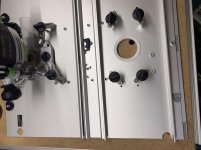onevw
Member
- Joined
- Mar 26, 2015
- Messages
- 105
I just noticed my CMS router top plate is not flat.
It's sunken down in the center long length when putting a 2-foot Woodpecker scale on the router top plate.
So it's down 10 thousand compared to the ends.
What the tolerance expected from Festool on the router top plate?
Rick
It's sunken down in the center long length when putting a 2-foot Woodpecker scale on the router top plate.
So it's down 10 thousand compared to the ends.
What the tolerance expected from Festool on the router top plate?
Rick




